
Bravo Intercept 5.2m at 3.1% Cu and 1.1g/t Au at T5 Target

Drilling at T11 Target intersects four significant sulphide-rich intervals
Bravo Mining Corp. (TSX-V: BRVO) (OTCQX: BRVMF) has received assay results from the two drills hole at the “T5” target, and intersected sulphide mineralization in drilling at the “T11″ electromagnetic ” target at its 100% owned Luanga Project which includes the Luanga palladium + platinum + rhodium + gold + nickel deposit, in the Carajás Mineral Province, Brazil.
“Bore-Hole EM is now progressing on all holes at EM target T5. This will better define the orientation of mineralization ahead of drill testing. Whilst it was anticipated from the lesser amounts of copper mineralization in DDH2405T003 that grade may not be as high as assay results from previous holes, this intersect extends the higher-grade copper-gold mineralization over a significant area. Target T5 therefore remains open along strike and depth which is interpreted to be very promising” said Luis Azevedo, Chairman and CEO. “Drilling also continues to advance other targets within the portfolio of EM anomalies. At T11, drilling of BHEM anomalies has intersected multiple zones of sulphide mineralization and while this is also very encouraging, we are still at early stage of these discoveries with a regular flow of exciting news expected in near future” he said.
- Hole DDH2405T003 at T5 Target, located 50m west and along strike of previously reported high-grade hole DDH2405T002, intersected 5.2m of semi-massive/breccia hosted copper sulphide mineralization grading 3.1% Cu and 1.1g/t Au (Figure 2).
- Copper-gold mineralization at T5 Target remains open at depth and along strike.
- BHEM surveys at T5 is in progress, including holes DDH2405T003, 04, 05 and 06 which will position Bravo for the August drill program.
- At T11, drill hole DDH2411T002 intersected four significant sulphide-rich intervals within a broader alteration zone. Pyrrhotite > pentlandite >> chalcopyrite is present as patches/veins, locally massive to semi-massive textures (Figure 1. Assays pending). BHEM in progress.

Figure 1: Massive sulphide mineralization in DDH2411T002 at T11 (224.1m to 224.4m downhole). Open along strike and at depth.
Exploration Drilling Update
Assay results have been received from diamond drill holes DDH2405T003 and DDH2405T005 at the T5 target, located 1km east of the Luanga PGM Deposit. Drill hole DDH2405T006 has also been completed and intersected strong alteration interpreted to be proximal to the mineralization (assays pending). BHEM was completed on the pilot hole (DDH2311T001) at HeliTEM target “T11“. BHEM anomalies defined from this drill hole indicated that the targets were deeper, below the drill hole. These refined targets were then successfully tested by DDH2411T002, which intersected sulphide mineralization. Together, this drilling of HeliTEM and BHEM anomalies comprises a total of 1,179 metres.
Bravo continues to conduct systematic first-pass drilling, coupled with BHEM, on the priority EM conductors identified by the HeliTEM survey. Although these modelled HeliTEM conductors have a lower degree of locational accuracy, they are sufficiently defined to position first-pass drilling proximal to the conductor’s location. From there, BHEM provides more precise location of EM anomalies for drill testing. Of the 17 priority EM anomalies identified in the HeliTEM survey (see press release September 11, 2023), Bravo had narrowed this list to 11 high priority conductors that warranted follow-up drilling of predominantly off-hole BHEM conductors. T5, T6, T16 and now T11 are four of these 11 HeliTEM targets.
T5 Target
Figure 2 shows the mineralization intersected in DDH2405T003 at the T5 target (Figure 5), located 50m west and along strike of previously reported high-grade copper-gold mineralization in hole DDH2405T002 (see press release May 28, 2023) which intercepted 11.48m at 14.3% Cu, 3.3g/t Au including 2.9m at 22.9% Cu, 3.6g/t Au.

Figure 2: Breccia copper sulphides in DH2405T003 (158.9 – 162.5m shown).
Drill hole DDH2405T003 (Figure 3) intersected 5.2m (grading 3.1% Cu, 1.1g/t Au) of breccia-hosted copper sulphide mineralization, at the T5 target. Like hole DDH2405T002, located 50m to the east, mineralization is interpreted to be consistent with typical copper/gold mineralization seen in the Carajás Mineral Province, and unrelated to the Luanga PGM+Au+Ni Deposit.
DDH2405T006 (Figure 3. Assays pending) has been completed down-dip of (below) hole DH2405T002, intersecting significant hydrothermal alteration consistent with that expected proximal (close) to the mineralization. Drilling is paused while BHEM (Figure 4) is completed on drill holes DDH2405T003,
DDH2405T004, DDH2405T005 and DDH2405T006 to better establish the dip/plunge of mineralization before the next round of drilling.
DDH2405T005, located up dip of (above) DDH2405T002 (Figure 3), intersected weathered mineralization in the oxidized zone, where mineralization is interpreted to be weathered away.
T5 mineralization remains open along strike, and down dip. BHEM surveying is in progress (Figure 4).
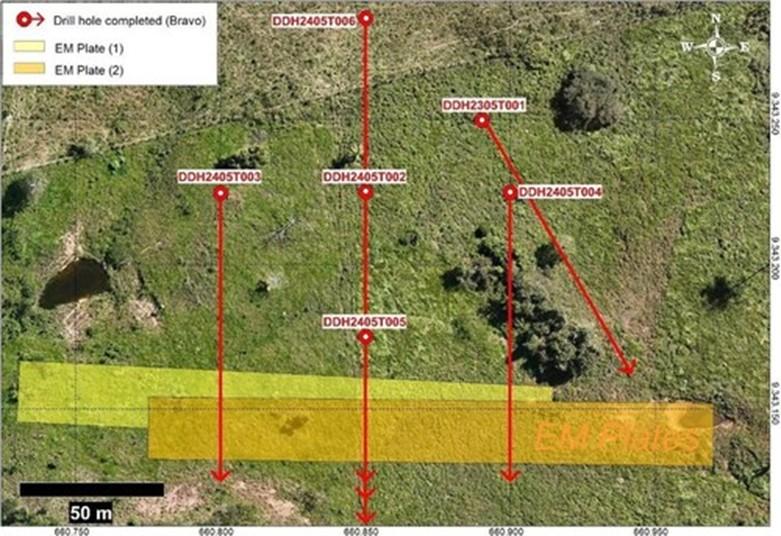
Figure 3: Off-hole conductors at T5 generated from DDH2405T001. Location of drill holes DDH2405T003, DDH2405T005 and DDH2405T006.
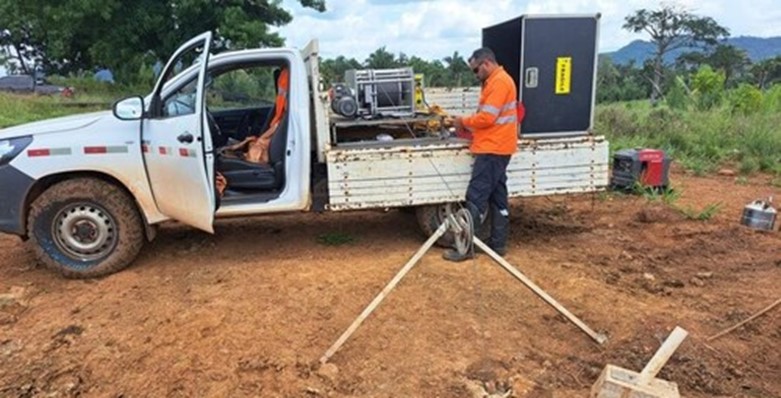
Figure 4: BHEM survey team in operation at the T5 Target – drill holes DDH2405T003, DDH2405T004, DDH2405T005 and DDH2405T006.
T11 Target
The T11 target is located proximal to the ultramafic footwall of the Central Sector of the Luanga PGM+Au+Ni deposit. The pilot drill hole (DDH2311T001, Figure 5) targeting the HeliTEM anomaly was shown to be too shallow and was drilled up-dip of the EM conductors which were subsequently better defined by BHEM to be deeper. DDH2411T002 (Figure 5) targeted the center of this group of 10 conductors at a more appropriate depth, successfully intersecting four zones of mineralization within an approximately 190m wide hydrothermal alteration zone.
Figure 6 shows the intersected mineralization, which consists of four sulphide-rich intervals within the hydrothermal alteration system. Mineralization presents as patches and veins, locally reaching massive (Figure 1) to semi-massive textures. The main sulphide paragenesis is pyrrhotite > pentlandite (Ni sulphide) >> chalcopyrite (Cu sulphide), thus generating a strong EM response made up of multiple conductors, which present as the four sulphide-rich zones intersected. Assays are pending.
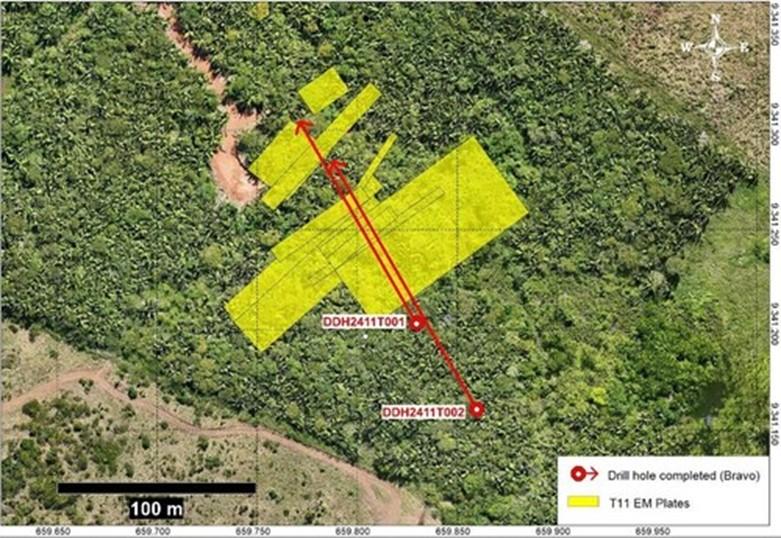
Figure 5: Off-hole conductors at T11 generated from DDH2411T001. Location of drill holes DDH2411T001 and 002
At 96m depth drill hole DDH2411T002 intersects the ultramafic footwall of the Luanga deposit, intersecting an Fe-Ca alteration system which consists of magnetite, grunerite, hornblende, actinolite, biotite and almandine. This mineralogical assemblage is similar to other IOCG-style mineralized systems that occur within the Carajás Mineral Province, and is likely unrelated to the primary Luanga PGM deposit mineralization which is at a stratigraphically higher level. BHEM will be completed on DDH2411T002 prior to commencing follow-up drilling.
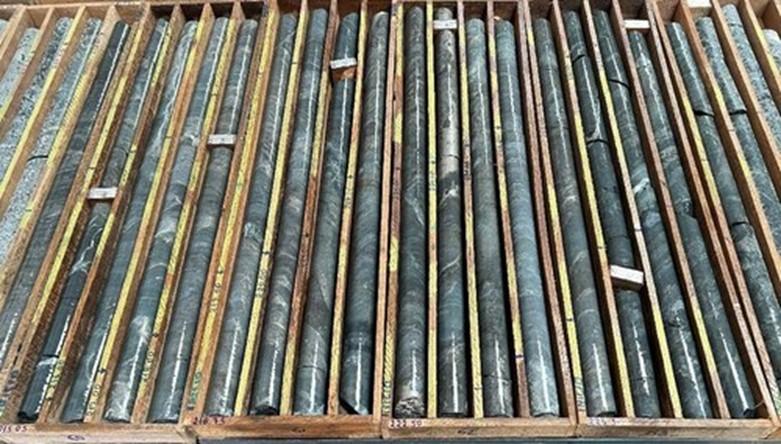
Figure 6: DDH2411T002 Sulphide mineralization – patches and veins, locally reaching massive/semi-massive (215m to 230m shown).
Drill Results Status Update
A total of 304 drill holes have been completed to date by Bravo, for 65,113 metres, including 8 metallurgical holes (not subject to routine assaying). Results have been reported for 252 Bravo drill holes to date. Assay results for 44 Bravo drill holes that have been completed are currently outstanding (excluding the metallurgical holes). Bravo plans to extend the current EM drilling program from 3,000m to 8,000m, to continue drilling testing and follow up drilling of EM anomalies.
Complete Table of Recent Intercepts.
| HOLE-ID | Target | From (m) | To (m) | Thickness (m) | Cu (%) Sulphide |
Au (g/t) | TYPE |
| DDH2405T003 | T5 | 157.91 | 163.10 | 5.19 | 3.10 | 1.12 | FR |
| DDH2405T005 | T5 | 43.50 | 48.50 | 5.00 | 0.59 | 0.19 | FR |
| DDH2411T001 | T11 | No Significant Result | |||||
| Notes: | All ‘From’, ‘To’ depths, and ‘Thicknesses’ are downhole. | ||||||
| Based on the limited drilling data available, the true thickness of mineralization is currently unknown. | |||||||
| Type: FR = Fresh Rock. Recovery methods and results will differ based on the type of mineralization. | |||||||
| * Bravo’s Copper/nickel grades are sulphide, and do not include non-recoverable silicates. | |||||||
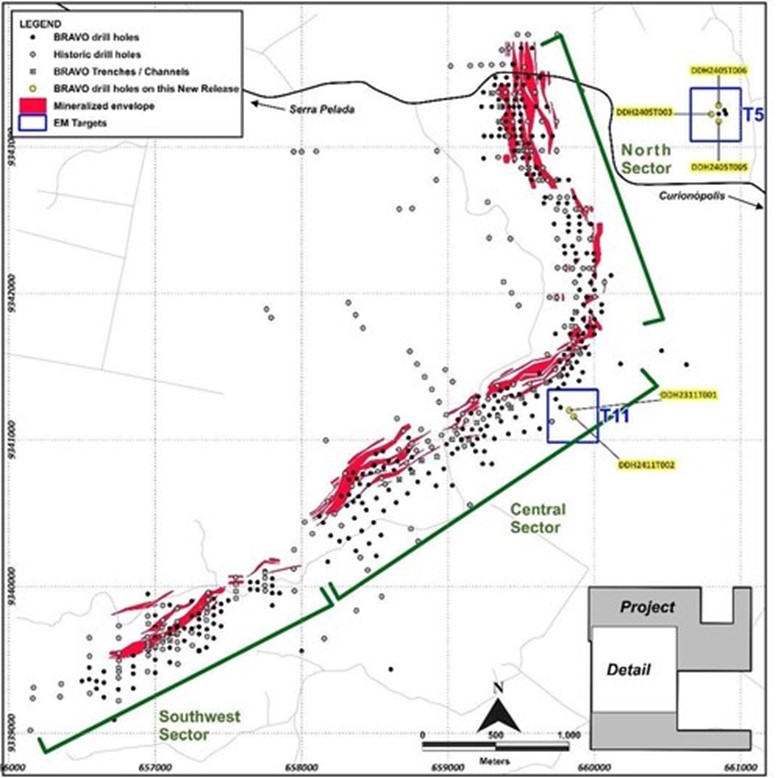
Figure 7: Location of Bravo Drilling at the T5 and T11 targets, reported in this News Release
About Bravo Mining Corp.
Bravo is a Canadian and Brazil-based mineral exploration and development company focused on advancing its Luanga Project in the world-class Carajás Mineral Province of Brazil
Bravo is the most active explorer in Carajás. The team, comprising local and international geologists, has a proven track record of PGM, nickel, and copper discoveries in the region. They have successfully taken a past IOCG greenfield project from resource definition to development and production in Carajás.
The Luanga Project is situated on mature freehold farming land and benefits from being in a location close to operating mines and a mining-experienced workforce, with excellent access and proximity to existing infrastructure, including road, rail, and clean renewable hydro grid power. A fully funded 63,000m infill, step out and exploration drilling and trenching program is well advanced for 2024. Bravo’s current Environmental, Social and Governance activities includes planting more than 30,000 high-value trees in the project area, hiring and contracting locally, and ensuring protection of the environment during its exploration activities.
Technical Disclosure
Technical information in this news release has been reviewed and approved by Simon Mottram, F.AusIMM (Fellow Australia Institute of Mining and Metallurgy), President of Bravo Mining Corp. who serves as the Company’s “qualified person” as defined in National Instrument 43-101 Standards of Disclosure for Mineral Projects. Mr. Mottram has verified the technical data and opinions contained in this news release.
Schedule 1: Drill Hole Collar Details
| HOLE-ID | Company | East (m) | North (m) | RL (m) | Datum | Depth (m) | Azimuth | Dip | Area |
| DDH2405T003 | Bravo | 660800.010 | 9343224.570 | 195.120 | SIRGAS2000_UTM_22S | 180.20 | 180.00 | -60.00 | T5 Target |
| DDH2405T005 | Bravo | 660850.000 | 9343175.020 | 194.850 | SIRGAS2000_UTM_22S | 125.05 | 180.00 | -60.00 | T5 Target |
| DDH2405T006 | Bravo | 660850.030 | 9343284.780 | 188.240 | SIRGAS2000_UTM_22S | 350.75 | 180.00 | -60.00 | T5 Target |
| DDH2311T001 | Bravo | 659829.736 | 9341203.238 | 180.447 | SIRGAS2000_UTM_22S | 233.70 | 330.00 | -60.00 | T11 Target |
| DDH2411T002 | Bravo | 659859.870 | 9341160.210 | 178.870 | SIRGAS2000_UTM_22S | 288.90 | 330.00 | -60.00 | T11 Target |
Schedule 2: Assay Methodologies and QAQC
Samples follow a chain of custody between collection, processing, and delivery to the SGS Geosol laboratory in Parauapebas, state of Pará, Brazil. The drill core is delivered to the core shack at Bravo’s Luanga site facilities and processed by geologists who insert certified reference materials, blanks, and duplicates into the sampling sequence. Drill core is half cut and placed in secured polyurethane bags, then in security-sealed sacks before being delivered directly from the Luanga site facilities to the Parauapebas SGS Geosol laboratory by Bravo staff. Additional information about the methodology can be found on the SGS Geosol website (SGS) in their analytical guides. Information regarding preparation and analysis of historic drill core is also presented in the table below, where the information is known.
Quality Assurance and Quality Control is maintained internally at the lab through rigorous use of internal certified reference materials, blanks, and duplicates. An additional QAQC program is administered by Bravo using certified reference materials, duplicate samples and blank samples that are blindly inserted into the sample batch. If a QAQC sample returns an unacceptable value an investigation into the results is triggered and when deemed necessary, the samples that were tested in the batch with the failed QAQC sample are re-tested.
| Bravo SGS Geosol | ||||
| Preparation | Method | Method | Method | Method |
| For All Elements | Pt, Pd, Au | Rh | Sulphide Ni, Cu | Trace Elements |
| PRPCLI (85% at 200#) | FAI515, FAI34V | FAI30V | AA04B | ICP40B |
MORE or "UNCATEGORIZED"
Doubleview Extends High-Grade Domains at Hat: H099 Returns 438m of 0.40% CuEq Including 52m of 1.02% CuEq, Expanding Mineralization Envelope Around Conceptual Pit Vertically and Laterally
Doubleview Gold Corp. (TSX-V: DBG) (OTCQB: DBLVF) (FSE: 1D4) is pleased to announce assay results f... READ MORE
Cosa Closes Upsized C$7.5 Million Private Placement
Cosa Resources Corp. (TSX-V: COSA) (OTCQB: COSAF) (FSE: SSKU) is pleased to announce that it ... READ MORE
Americas Gold and Silver Closes US$132.25 Million Bought Deal Financing
Americas Gold and Silver Corporation (TSX: USA) (NYSE American: USAS) is pleased to report that it h... READ MORE
1911 Gold Closes C$23 Million "Best Efforts" Life Offering & Private Placement and Provides Corporate Updates
1911 Gold Corporation (TSX-V: AUMB) (FRA: 2KY) is pleased to announce that it has completed its prev... READ MORE
Endeavour Silver Completes US$350 Million Offering of Convertible Senior Notes
Endeavour Silver Corp. (NYSE: EXK) (TSX: EDR) announced today the closing of its previously announce... READ MORE












